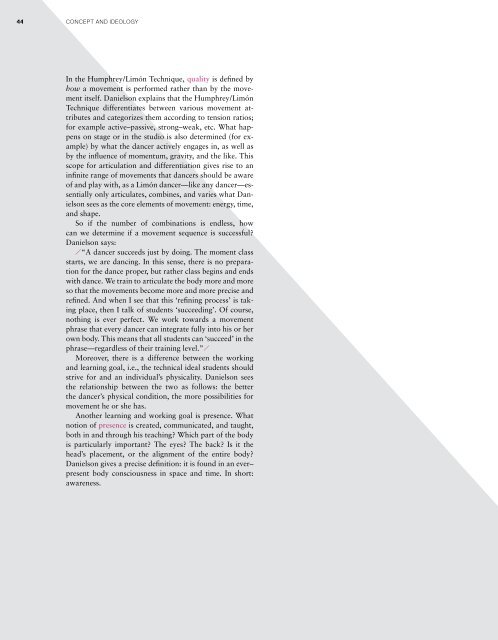Dance Techniques 2010
What does today's contemporary dance training look like? Seven research teams at well known European dance universities have tackled this question by working with and querying some of contemporary dance s most important teachers: Alan Danielson, Humphrey/Limón Tradition, Anouk van Dijk, Countertechnique, Barbara Passow, Jooss Leeder Technique, Daniel Roberts Cunningham Technique, Gill Clarke Minding Motion, Jennifer Muller Muller Technique, Lance Gries Release and Alignment Oriented Techniques. This comprehensive study includes interviews, scholarly contributions, and supplementary essays, as well as video recordings and lesson plans. It provides a comparative look into historical contexts, movement characteristics, concepts, and teaching methods. A workbook with two training DVDs for anyone involved in dance practice and theory. Ingo Diehl, Friederike Lampert (Eds.), Dance Techniques 2010 – Tanzplan Germany. With two DVDs. Berlin: Henschel 2011. ISBN 978-3-89487-689-0 (Englisch) Out of print.
What does today's contemporary dance training look like? Seven research teams at well known European dance universities have tackled this question by working with and querying some of contemporary dance s most important teachers: Alan Danielson, Humphrey/Limón Tradition, Anouk van Dijk, Countertechnique, Barbara Passow, Jooss Leeder Technique, Daniel Roberts Cunningham Technique, Gill Clarke Minding Motion, Jennifer Muller Muller Technique, Lance Gries Release and Alignment Oriented Techniques.
This comprehensive study includes interviews, scholarly contributions, and supplementary essays, as well as video recordings and lesson plans. It provides a comparative look into historical contexts, movement characteristics, concepts, and teaching methods. A workbook with two training DVDs for anyone involved in dance practice and theory.
Ingo Diehl, Friederike Lampert (Eds.), Dance Techniques 2010 – Tanzplan Germany. With two DVDs. Berlin: Henschel 2011. ISBN 978-3-89487-689-0 (Englisch) Out of print.
Create successful ePaper yourself
Turn your PDF publications into a flip-book with our unique Google optimized e-Paper software.
44<br />
Concept and Ideology<br />
In the Humphrey / Limón Technique, quality is defined by<br />
how a movement is performed rather than by the movement<br />
itself. Danielson explains that the Humphrey / Limón<br />
Technique differentiates between various movement attributes<br />
and categorizes them according to tension ratios;<br />
for example active–passive, strong–weak, etc. What happens<br />
on stage or in the studio is also determined (for example)<br />
by what the dancer actively engages in, as well as<br />
by the influence of momentum, gravity, and the like. This<br />
scope for articulation and differentiation gives rise to an<br />
infinite range of movements that dancers should be aware<br />
of and play with, as a Limón dancer—like any dancer—essentially<br />
only articulates, combines, and varies what Danielson<br />
sees as the core elements of movement: energy, time,<br />
and shape.<br />
So if the number of combinations is endless, how<br />
can we determine if a movement sequence is successful?<br />
Danielson says:<br />
“A dancer succeeds just by doing. The moment class<br />
starts, we are dancing. In this sense, there is no preparation<br />
for the dance proper, but rather class begins and ends<br />
with dance. We train to articulate the body more and more<br />
so that the movements become more and more precise and<br />
refined. And when I see that this ‘refining process’ is taking<br />
place, then I talk of students ‘succeeding’. Of course,<br />
nothing is ever perfect. We work towards a movement<br />
phrase that every dancer can integrate fully into his or her<br />
own body. This means that all students can ‘succeed’ in the<br />
phrase—regardless of their training level.”<br />
Moreover, there is a difference between the working<br />
and learning goal, i.e., the technical ideal students should<br />
strive for and an individual’s physicality. Danielson sees<br />
the relationship between the two as follows: the better<br />
the dancer’s physical condition, the more possibilities for<br />
movement he or she has.<br />
Another learning and working goal is presence. What<br />
notion of presence is created, communicated, and taught,<br />
both in and through his teaching? Which part of the body<br />
is particularly important? The eyes? The back? Is it the<br />
head’s placement, or the alignment of the entire body?<br />
Danielson gives a precise definition: it is found in an ever–<br />
present body consciousness in space and time. In short:<br />
awareness.


















